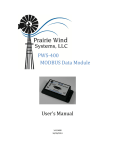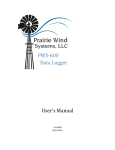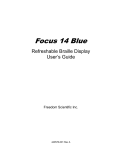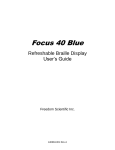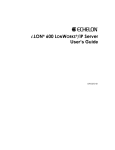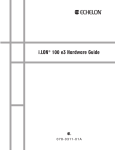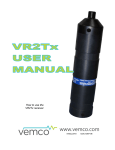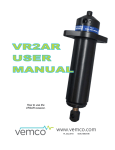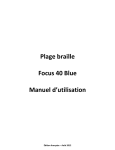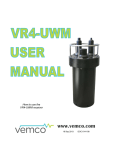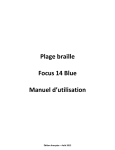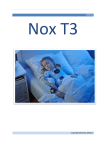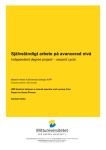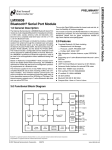Download PWS-420 User`s Manual - Prairie Wind Systems
Transcript
PWS-420 MODBUS Data Module With Bluetooth User’s Manual 14-10420 10/20/2013 PWS-420 User’s Manual Copyright © 2012, 2013 by Prairie Wind Systems, LLC. All Rights Reserved. No part of this document may be photocopied, reproduced, or translated to another language without the prior written consent of Prairie Wind Systems. The information contained in this document is subject to change without notice. Prairie Wind Systems has made a reasonable effort to ensure that the information contained in this document is accurate as of the date of publication. Prairie Wind Systems makes no warranty of any kind with regards to this material, including, but not limited to, its fitness for a particular application. Prairie Wind Systems will not be liable for errors contained herein or for incidental or consequential damages in connection with the furnishing, performance, or use of this material. In no event shall Prairie Wind Systems be liable for any claim for direct, incidental, or consequential damages arising out of, or in connection with, the sale, manufacture, delivery, or use of any product. 2 PWS-420 User’s Manual 1 2 3 4 5 6 7 Regulatory Information......................................................................................................................... 6 1.1 FCC Statement............................................................................................................................... 6 1.2 IC (Industry Canada) Statement .................................................................................................... 6 1.3 Battery Statement......................................................................................................................... 7 Warranty and Assistance ...................................................................................................................... 8 Overview ............................................................................................................................................... 9 Specifications ...................................................................................................................................... 10 Installation .......................................................................................................................................... 12 5.1 Environmental Considerations.................................................................................................... 12 5.2 Mounting the Device................................................................................................................... 12 5.3 Connector Pin-Out ...................................................................................................................... 13 5.3.1 Power Requirements .......................................................................................................... 13 5.3.2 RS485 Signals ...................................................................................................................... 14 5.3.3 Bluetooth Wake-up Input ................................................................................................... 14 5.4 Terminal Block Accessory............................................................................................................ 14 Getting Started.................................................................................................................................... 15 6.1 Device Configuration................................................................................................................... 15 6.2 Establishing a Bluetooth Connection .......................................................................................... 15 6.3 Network Communication Settings .............................................................................................. 16 6.4 Site Identification ........................................................................................................................ 16 Register Map ....................................................................................................................................... 17 7.1 Device Configuration Registers ................................................................................................... 17 7.1.1 Register Map Version .......................................................................................................... 17 7.1.2 Device Id .............................................................................................................................. 17 7.1.3 Serial Number ..................................................................................................................... 17 7.1.4 Firmware Version ................................................................................................................ 17 7.1.5 Boot Code Version .............................................................................................................. 17 7.1.6 Hardware Version ............................................................................................................... 18 7.1.7 Site Id .................................................................................................................................. 18 7.1.8 Site Name ............................................................................................................................ 18 7.1.9 Site Information .................................................................................................................. 18 7.1.10 Device Address .................................................................................................................... 18 7.1.11 Low Voltage Warning Threshold ......................................................................................... 18 7.2 Device Command Register .......................................................................................................... 19 7.3 Device Status Registers ............................................................................................................... 20 7.3.1 Device Status ....................................................................................................................... 20 7.3.2 Ambient Temperature ........................................................................................................ 21 7.3.3 Input Voltage....................................................................................................................... 21 7.3.4 Charge Voltage .................................................................................................................... 21 7.3.5 Date and Time ..................................................................................................................... 21 7.4 RS485 Configuration Registers .................................................................................................... 22 7.4.1 RS485 Communication Settings .......................................................................................... 22 7.4.2 RS485 Message Timeout ..................................................................................................... 23 7.4.3 RS485 Sleep Timeout .......................................................................................................... 23 7.4.4 RS485 Message Counters .................................................................................................... 23 7.5 Bluetooth Configuration Registers.............................................................................................. 24 3 PWS-420 User’s Manual 7.5.1 Communication Settings ..................................................................................................... 24 7.5.2 Message Timeout ................................................................................................................ 25 7.5.3 Message Counters............................................................................................................... 25 7.5.4 Bluetooth Passkey ............................................................................................................... 25 7.5.5 Bluetooth Scanning Schedule ............................................................................................. 26 7.5.6 Bluetooth Information Registers ........................................................................................ 26 7.6 Data Log Recording Registers ..................................................................................................... 27 7.6.1 Encryption Key .................................................................................................................... 27 7.6.2 Recording Data .................................................................................................................... 27 7.6.3 Calculating Data Record Capacity ....................................................................................... 28 7.6.4 Recording Speed ................................................................................................................. 29 7.7 Data Log Retrieval Registers ....................................................................................................... 30 7.7.1 Data Log Size ....................................................................................................................... 30 7.7.2 Data Log Used ..................................................................................................................... 30 7.7.3 Lowest and Highest Record Numbers ................................................................................. 30 7.7.4 Download Record Count ..................................................................................................... 31 7.7.5 Record Number ................................................................................................................... 31 7.7.6 Record Size .......................................................................................................................... 31 7.7.7 Record Data......................................................................................................................... 31 7.7.8 Data Decryption .................................................................................................................. 31 7.7.9 Data Retrieval Procedure .................................................................................................... 32 7.7.10 Data Log Download Command ........................................................................................... 32 7.8 Password Security Registers ....................................................................................................... 34 7.8.1 Security Password ............................................................................................................... 34 7.8.2 Login Password ................................................................................................................... 34 7.9 Diagnostic Registers .................................................................................................................... 35 7.9.1 Configuration Flash Writes.................................................................................................. 35 7.9.2 Last Reset Type ................................................................................................................... 35 7.9.3 Fault Information ................................................................................................................ 36 7.9.4 High and Low Temperatures ............................................................................................... 36 7.9.5 Data Log Chip Id .................................................................................................................. 36 7.9.6 Data Log Erasure Count....................................................................................................... 36 8 MODBUS Protocol ............................................................................................................................... 37 8.1 RTU Transmission Mode ............................................................................................................. 37 8.1.1 RTU Character Format ........................................................................................................ 37 8.1.2 RTU Message Format .......................................................................................................... 38 8.2 ASCII Transmission Mode............................................................................................................ 38 8.2.1 ASCII Character Format ....................................................................................................... 38 8.2.2 ASCII Message Format ........................................................................................................ 39 8.3 Device Addressing ....................................................................................................................... 39 8.4 Data Types................................................................................................................................... 40 8.4.1 USHORT: Unsigned Short ................................................................................................... 40 8.4.2 SHORT: Signed Short .......................................................................................................... 40 8.4.3 ULONG: Unsigned Long ...................................................................................................... 40 8.4.4 LONG: Signed Long ............................................................................................................. 40 8.4.5 FLOAT: Floating Point ......................................................................................................... 41 4 PWS-420 User’s Manual 8.4.6 STRING: Character String ................................................................................................... 41 8.4.7 TIME: Date and Time .......................................................................................................... 42 8.5 Function Codes............................................................................................................................ 43 8.5.1 Report Slave Id .................................................................................................................... 43 8.5.2 Read Registers ..................................................................................................................... 43 8.5.3 Write Multiple Registers ..................................................................................................... 45 8.5.4 Write Single Register ........................................................................................................... 46 8.5.5 Exception Response ............................................................................................................ 47 5 PWS-420 User’s Manual 1 Regulatory Information The PWS-420 has been tested and approved to be compliant to the following regulatory standards. EN61326-1: 2006, for immunity in industrial locations (CE) EN55011: 2009, Class A, Group 1, for emissions (CE) EN300 328 v1.7.1 (CE) EN301 489-17 v1.2.1 (CE) RSS-GEN Issue 1 (IC) RSS-210 Issue 7, Annex 8 and RSS-GEN Issue 2 (IC) CISPR 11, Ed. 5.0, 2009-05, Class A, Group 1, for emissions CFR Title 47: FCC Part 15, Class A, for emissions FCC Part 15, Subpart C Any changes or modifications not expressly approved by the party responsible for compliance could void the user's authority to operate the equipment. 1.1 FCC Statement This device has been tested and found to comply with the limits for a Class A digital device, pursuant to part 15 of the FCC Rules. These limits are designed to provide reasonable protection against harmful interference when the equipment is operated in a commercial environment. This device generates, uses and can radiate radio frequency energy and, if not installed and used in accordance with this manual, may cause harmful interference to radio communications. Operation of this device in a residential area is likely to cause harmful interference in which case the user will be required to correct the interference at his own expense. Caution: Exposure to Radio Frequency Radiation This device contains transmitter module FCC ID: ED9LMX9838. This device must not be co-located or operated in conjunction with any other antenna or transmitter. 1.2 IC (Industry Canada) Statement This device complies with RSS 210 of Industry Canada. Operation is subject to the following two conditions: (1) this device may not cause interference, and (2) this device must accept any interference, including interference that may cause undesired operation of this device. Cet appareil est conforme à la norme RSS 210 d'Industrie Canada. Son fonctionnement est soumis aux deux conditions suivantes: (1) cet appareil ne peut pas provoquer d'interférences et (2) cet appareil doit accepter toute interférence, y compris les interférences pouvant causer un mauvais fonctionnement de ce dispositif. 6 PWS-420 User’s Manual Caution: Exposure to Radio Frequency Radiation This device contains transmitter module IC: 1520A-LMX9838. The installer of this radio equipment must ensure that the antenna is located or pointed such that it does not emit RF field in excess of Health Canada limits for the general population; consult Safety Code 6, obtainable from Health Canada's website http://www.hc-sc.gc.ca/rpb. 1.3 Battery Statement This device contains a poly-carbonmonoflouride lithium coin cell battery to preserve the real-time clock when power is not applied. The Department of Transportation requires that the outside of each package that contains primary lithium batteries, regardless of the size or number of batteries, be labeled with the following statement: “PRIMARY LITHIUM BATTERIES – FORBIDDEN FOR TRANSPORT ABOARD PASSENGER AIRCRAFT”. The labeling requirement covers shipping via highway, rail, vessel or cargo-only aircraft and covers all shipments into or out of the United States. The label must be in contrasting color and the letters must be 12 mm (0.5 in) in height for packages weighing more than 30 Kg and 6 mm (0.25 in) in height for packages weighing less than 30 Kg. The lithium battery does not contain enough lithium to qualify as a reactive hazardous waste. The battery is safe for disposal in the normal municipal waste stream. 7 PWS-420 User’s Manual 2 Warranty and Assistance The PWS-420 is warranted by Prairie Wind Systems, LLC to be free from defects in materials and workmanship under normal use and service for twelve (12) months from the date of shipment unless specified otherwise. Prairie Wind Systems’ obligation under this warranty is limited to repairing or replacing, at Prairie Wind Systems’ option, defective products. The customer shall assume all costs of removing, reinstalling, and shipping defective products to Prairie Wind Systems. Prairie Wind Systems will return such products by surface carrier prepaid. This warranty shall not apply to any product which has been subjected to modification, misuse, neglect, accidents of nature, or shipping damage. This warranty is in lieu of all other warranties, expressed or implied, including warranties of merchantability or fitness for a particular purpose. Prairie Wind Systems is not liable for special, indirect, incidental, or consequential damages. Products may not be returned without prior authorization. To obtain a Returned Materials Authorization (RMA) number, contact Prairie Winds Systems at the phone number below. Please write the RMA number clearly on the outside of the shipping container. Prairie Wind Systems’ shipping address is: Prairie Wind Systems, LLC RMA #____________ 7784 Big Sky Court Windsor, CO 80550 Phone: 970.460.6066 Fax: 970.692.2434 8 PWS-420 User’s Manual 3 Overview The PWS-420 adds data logging capability to the master device of any MODBUS RS485 network. Standard write and read register commands are used to store and recall data in non-volatile memory. Data records are free-format and are automatically time-stamped and check-summed. Data records can be encrypted for maximum data security. When the memory is full, recording automatically wraps around to record the newest data over the oldest data. In addition to the primary data logging feature, the PWS-420 extends the capabilities of a system with these additional features. The Bluetooth interface provides safe, secure, wireless access to the system for configuration, status, and data retrieval. Data can be recorded and retrieved securely using the Advanced Encryption Standard with a user-defined key. The PWS-420 includes an accurate, temperature-compensated, real-time clock. Every data record logged to the device is date and time stamped. The clock is also available to the system master device via simple register reads. The device’s ambient temperature sensor is also available via register access. In addition to providing temperature compensation for the real-time clock, the ambient temperature is also logged with every data record for enhanced data tracking and system troubleshooting. The PWS-420 measures and records its system power input voltage. This value enhances data tracking and system troubleshooting, particularly in battery operated systems. The user can track battery and recharging performance in standalone and solar charged systems. The Prairie View Software that comes with the device provides a convenient means to configure the device and manage its data log. 9 PWS-420 User’s Manual 4 Specifications Case Description Dimensions Weight Ratings Connector Environmental Operating Temperature Operating Humidity Storage Temperature Power Input Input Voltage Transient Protection Sleep Current Idle Current Active Current Bluetooth Scanning Bluetooth Active RS485 Transceiver Unit Load Termination Common Mode Range Transient Protection Protocol Transmission Modes Addressing Baud Rates Data Bits Parity Stop Bits Bluetooth Transceiver Antenna Range Modes Security Transmission Modes Addressing ABS plastic with integral mounting flanges 4.61”L x 2.32”W x 1.30”H (11.7 x 5.9 x 3.3 cm) including flanges and connector 3.5 oz (100 g) IP 66 and NEMA 4X 9-pin D-sub socket -40 to 70 °C (-40 to 158 °F) 5 to 95 %RH non-condensing -40 to 80 °C (-40 to 176 °F) 8 to 32 Vdc 250 Watts Peak 20 µA typical at 13.5 Vdc, network inactive 100 µA typical at 13.5 Vdc, network inactive 10 mA typical at 13.5 Vdc 5 mA typical at 13.5 Vdc 20 mA typical at 13.5 Vdc 1/8 None +/- 7 Vdc 250 Watts Peak Half-Duplex, MODBUS over Serial Line RTU, ASCII 1 to 247 plus broadcast 1200, 2400, 4800, 9600, 19200, 38400, 57600 7, 8 Odd, Even, None 1, 2 Internal ~30 ft (10 m) Push-to-talk with external switch, scheduled scanning Passkey RTU, ASCII 1 to 247 10 PWS-420 User’s Manual Data Storage Memory Type Data Record Size Number of Data Records Recording Rate 4 MB non-volatile flash 1 to 64 registers (2 to 128 bytes) 131,008 (1 register per record, no encryption) to 25,216 (64 registers per record, with encryption) 1 record per second with no wraparound 1 record per 5 seconds after wraparound Recording Endurance 50,000 wraparound and erase cycles Data Security AES-128 Advanced Encryption Standard Data Retention 10 years General-Purpose Registers Configuration Registers 32 (64 bytes) non-volatile flash Data Registers 64 (128 bytes) volatile RAM Access Simultaneous read/write via RS485 and Bluetooth Real-Time Clock Resolution 0.01 seconds Accuracy +/- 1 minute per month, temperature compensated Backup Battery Life 10 years Temperature Sensor Resolution 0.1 °C Accuracy +/- 3 °C Voltage Sensor Resolution 0.01 Vdc Accuracy +/- 0.05 Vdc 11 PWS-420 User’s Manual 5 Installation 5.1 Environmental Considerations The PWS-420 is specified for operation in a non-condensing humidity environment. When temperature and/or humidity tolerances are exceeded, damage to internal components and/or measurement inaccuracies due to condensation may result. The device must be housed in an enclosure suited for field use. The environmental ratings of the device’s enclosure are intended as a backup to the primary field housing. The field housing should contain desiccant that is replaced or dried frequently enough to control the humidity. Effective control of the humidity is the user’s responsibility. With its Bluetooth interface, the PWS-420 can provide the ability to access the system without opening the field housing. To take advantage of this feature, the housing should be of plastic or fiberglass construction to permit good penetration of the radio signal. The Bluetooth interface may be activated by a push-button mounted to the outside of the enclosure and/or by programming a daily activation schedule. 5.2 Mounting the Device Mounting flanges are integral to the device’s enclosure. Six mounting holes sized for #4 screws are provided. Two or more screws should be used to mount the enclosure. 4.61” (11.71 cm) 2.32” (5.89 cm) 1.80” (4.57 cm) 4.09” (10.39 cm) 12 PWS-420 User’s Manual 5.3 Connector Pin-Out The PWS-420 uses a standard 9-pin D-subminiature socket. The sockets on the face of the connector are numbered as shown below. This is also the pin-out looking at the wiring side of the mating 9-pin D-sub plug. 5 4 9 3 8 2 7 1 6 The function of each pin is described below. The pin-out follows the MODBUS specification for RS485 connections using this style of connector. Pin 1 2 3 4 5 6 7 8 9 Name GROUND POWER MODE A RS485B+ D C B RS485A- Description Signal and power supply common Positive power input, 8 to 32 Vdc Bluetooth wake-up input, momentary switch to GROUND No connection RS485 transceiver positive terminal No connection No connection No connection RS485 transceiver negative terminal For reliability of the connection, the mating connector should utilize the 4-40 mounting standoffs provided. The cable length should be kept as short as practical. The maximum length of cable for an RS485 network is 4000 feet (1200 meters). 5.3.1 Power Requirements The wide input voltage range of the device permits operation on a 12 volt or 24 volt DC supply. The device will automatically shut down if the input voltage falls below 7 volts and will not resume normal operation until the input voltage rises above 8 volts. Sustained operation above 32 volts will damage the device. The input is reverse polarity and transient protected. Apply the positive side of the supply to pin 2 (POWER), the negative side to pin 1 (GROUND). 13 PWS-420 User’s Manual 5.3.2 RS485 Signals Pin 5 of the connector is the positive transceiver signal (RS485B+). Pin 9 is the negative transceiver signal (RS485A-). No termination resistor is supplied internally. In most applications, no termination resistor is necessary. If required, a resistor may be added externally. The maximum offset of the signals from the GROUND at pin 1 is 7 volts. Both signals are transient protected. 5.3.3 Bluetooth Wake-up Input The MODE input on pin 3 of the connector is used to wake up the Bluetooth radio for an immediate walk-up connection. Connect a normally open, momentary switch between this pin and GROUND. Pressing the switch will wake the Bluetooth radio. Optionally, this input may be tied to GROUND for continuous Bluetooth radio operation. Do not apply a voltage to this input. The input is transient protected. 5.4 Terminal Block Accessory The optional PWS-400T Terminal Block accessory board attaches to the 9-pin connector of the PWS-420 and provides terminal block connections for wiring all signals. A switch is provided on the board to implement the Bluetooth radio wake-up function, simplifying wiring when a remote switch is not needed. A remote switch may be wired in parallel using the MODE and GND terminals of TB2. Optionally, a jumper can be wired between MODE and GND for continuous Bluetooth radio operation. Note: Signals A, B, C, and D are not used on the PWS-420 and must be left unconnected. 14 PWS-420 User’s Manual 6 Getting Started The PWS-420 communicates as a slave device on an RS485 network using the industry standard MODBUS protocol for serial devices. This section provides guidelines to getting the device up and running on a network. If the device is not already wired, follow the installation instructions provided in the previous section. Section 7 describes the device register map. The PWS-420 uses the MODBUS Holding Registers data model exclusively. All of the device functionality is accessed using the MODBUS read and write holding register commands. Section 8 provides the details of the MODBUS protocol for users that are not familiar with MODBUS. Also refer to Section 8 for device-specific implementation information, such as the organization of registers into data types. 6.1 Device Configuration Configuring the device consists of writing user-specific settings to one or more of the device registers. The device may be configured through either its RS485 port or its Bluetooth port. The Prairie View Software supplied with the device provides a convenient, step-by-step means to configure the device and is the recommended place to start. Refer to the software manual for instructions on installing the software on your desktop computer, laptop computer, or mobile device. It is also possible to configure the device by directly writing to the registers using a master device with pass-through capability, or using a third-party software tool. 6.2 Establishing a Bluetooth Connection Use the following procedure to connect to the PWS-420 using Bluetooth. 1. The user’s desktop computer, laptop computer, or mobile device must have a Bluetooth radio and software installed. Many mobile devices and many laptop computers have Bluetooth built in. If Bluetooth is not already installed, USB-to-Bluetooth adapters are readily available. Follow the instructions for your device to install and activate the Bluetooth radio. 2. The PWS-420 will require that at least the POWER, GROUND, and MODE connections be made as described in the installation section. 3. Press the MODE switch to activate the device’s Bluetooth radio. The radio will remain active for about 10 minutes. If a connection is not successfully made within that time, the radio will go back to sleep, in which case it will be necessary to press the MODE switch again. 4. On the user’s computer, start the Bluetooth software and click on the option to “Connect” to a device, “New Connection”, or “Find Device”. 15 PWS-420 User’s Manual 5. Within a few seconds, the PWS-420 should appear in the list of devices to choose from. Select the PWS-420 and follow the on-screen instructions to establish a connection. If the software identifies the COM port used, make note of it. 6. At some point during the connection process, the Bluetooth software will prompt for a Bluetooth Passkey, sometimes called a Pairing Code, or PIN. The default Passkey for the device is “0000”. 7. If the Bluetooth software has not requested a passkey yet, the device may be identified but not yet connected. Double-click on the PWS-420 in the list, or follow the on-screen instructions to establish a connection. 8. Once the connection is made, you will need to know the COM port that has been assigned to the PWS-420. If the Bluetooth software has not identified the COM by this point, look for an option such as Properties, Details, or Status. The option may be a button, or may be found by right-clicking on the PWS-420 item. 9. Run the Prairie View Software or other third-party tool. When establishing the connection, select the Bluetooth COM port, 19200 baud, 8 data bits, even parity, one stop bit, RTU transmission mode, and device address 1. 10. Once a connection is established, the radio on the PWS-420 will remain on indefinitely until the connection is closed or lost. 6.3 Network Communication Settings Before the device is placed on an active RS485 network, it must be configured to match the network’s communication settings and be assigned a unique device address. The device is preconfigured with the MODBUS standard settings of 19200 baud, 8 data bits, even parity, 1 stop bit, RTU transmission mode, and device address 1. Refer to the Device Configuration section of the device register map to change the device address. Refer to the RS485 Configuration Registers section of the device register map if any of the communication settings need to be changed. 6.4 Site Identification If the user is collecting data from multiple devices located at different sites, it is recommended that the Site Id register be written with a unique value for each site. The Site Id is recorded with every data record, making it easier to track the data once it has been retrieved from a device. If multiple devices are located within Bluetooth radio range of each other, it is recommended that the Site Name registers be written with a unique name for each site. The site name will appear during the Bluetooth connection process, making it easier to connect to the correct site. 16 PWS-420 User’s Manual 7 Register Map The PWS-420 uses the MODBUS Holding Registers data model exclusively. All of the device functionality is accessed using the MODBUS read and write holding register commands. The organization of the register map is kept consistent among Prairie Wind System devices as much as practical. 7.1 Device Configuration Registers The device configuration registers identify the device, its site location, and its basic configuration. Device Configuration Registers Register Number 1000 1001 1002 1004 1005 1006 1007 1008 1024 1056 1057 Size (Registers) 1 1 2 1 1 1 1 16 32 1 1 Data Type USHORT USHORT ULONG USHORT USHORT USHORT USHORT STRING USHORT USHORT USHORT Access R R R R R R R/W R/W R/W R/W R/W Name Register Map Version Device Id Serial Number Firmware Version Boot Code Version Hardware Version Site Id Site Name Site Information Device Address Low Voltage Warning Threshold Default Value 2 420 0 0 0 1 9600 mV 7.1.1 Register Map Version This is the version of the register map supported by the device. This provides for the modification of the register map at a future date and detection of the difference by the master device. 7.1.2 Device Id This is the model number of the device. It can be used to validate the system configuration and to identify the available feature set. 7.1.3 Serial Number This is the serial number of the device. The master device can read the serial number of the device to provide system traceability. 7.1.4 Firmware Version This register identifies the firmware version of the device. 7.1.5 Boot Code Version This register identifies the boot code version of the device. The boot code supports field upgrades of the device firmware. The boot code on a given device will not change with firmware upgrades. Its version is made available to support field upgrade utilities. 17 PWS-420 User’s Manual 7.1.6 Hardware Version This register contains the hardware version of the device. 7.1.7 Site Id The Site Id is a general-purpose, non-volatile, read/write register. The contents of this register are recorded with each logged data record, permitting data to be traced to a particular site or system. 7.1.8 Site Name The Site Name identifies the site to a user. The 16-register, non-volatile string holds up to 32 characters. When connecting via Bluetooth, the site name is displayed during the connection process to aid in identifying a system when multiple systems are within range. Note: When the site name is changed, it will show as the Bluetooth name the next time a Bluetooth connection is made (changing the site name does not affect the Bluetooth name during the current session). The Bluetooth link must be disconnected for at least one minute before the change will take effect. 7.1.9 Site Information Site Information is comprised of 32, general-purpose, non-volatile, read/write registers. Use these registers to hold system configuration and/or calibration data. The format of the data contained in the registers is defined by the user. They can be used as individual registers or combined to form ULONG, FLOAT or STRING data types. These registers should not be used to hold data that changes frequently. 7.1.10 Device Address The device address is used to address the PWS-420 on both the RS485 interface and the Bluetooth interface. The valid range for the device address is 1 to 247. The default value is 1. When this register is written, the response will be returned with the previous address. All subsequent commands must be sent with the new address. The register is non-volatile. 7.1.11 Low Voltage Warning Threshold If the input voltage to the device is less than or equal to this threshold, the low voltage warning status bit is set in the device status register. The threshold is set in millivolts and can range from 8000 to 32000 mV (8 to 32 volts). Attempting to write a value outside this range will generate an exception response with the ILLEGAL WRITE VALUE exception code. 18 PWS-420 User’s Manual 7.2 Device Command Register The device command register is used to issue commands to the device. The register is isolated from other registers in the register map to help prevent accidental writing. Device Command Register Register Number 1065 Size (Registers) 1 Data Type USHORT Access R/W Name Device Command Default Value 0 Writing a value shown in the following table will issue the corresponding device command. Attempting to write any other value will generate an exception response with the ILLEGAL WRITE VALUE exception code. Reading the register always returns zero. Device Commands Value 56573 (0xDCFD) Name Factory Defaults 56557 (0xDCED) Erase Data Log 56541 (0xDCDD) Download Data Log 56320 (0xDC00) Security Mode Description Resets device configuration registers to their factory default values. Password security is disabled. The encryption key is erased and encryption is disabled. Does not affect the communication settings, the data log or the diagnostic registers. Erases the data log. Data cannot be recovered after issuing this command. The response message is sent after erasure is complete. Typical response time is 30 seconds. The maximum response time is 90 seconds. Erasing the data log does not affect the current encryption key. Starts the fast data download process. This command has a maximum response time of 1000 milliseconds. Refer to the Data Retrieval Registers section for a description of the command. Places the device in the security mode, requiring a master device to log in with a password to regain access. The command has no effect if password security is disabled. 19 PWS-420 User’s Manual 7.3 Device Status Registers The device status registers allow the master device to obtain the current operating status of the device. Device Status Registers Register Number 1070 1071 1072 1073 1074 Size (Registers) 1 1 1 1 4 Data Type USHORT SHORT USHORT USHORT TIME Access R/W R R R R/W Name Device Status Ambient Temperature Input Voltage Charge Voltage Date and Time Default Value 0 °C x 10 mV 0 mV UTC 7.3.1 Device Status This register contains device operational status. Each bit in the register represents a status value as defined in the following table. Device Status Register Bit 0 1 2 3 4 5 6 7 8 9 10 11 12 13 14 15 Mask 0x0001 0x0002 0x0004 0x0008 0x0010 0x0020 0x0040 0x0080 0x0100 0x0200 0x0400 0x0800 0x1000 0x2000 0x4000 0x8000 Name Power Outage Low Voltage Clock Battery Clock Fault Clock Adjusted Device Fault Temperature Reserved Encryption Enabled Reserved Reserved Reserved Reserved Reserved Reserved Reserved Description A power outage caused a hardware reset and recovery The input voltage is below the warning threshold Timekeeping backup battery is low Timekeeping restarted at 2000-01-01 00:00:00.00 Date and Time were changed A device fault caused a reset and recovery Device operating temperature range was exceeded Always returns 0 Encryption key is non-zero, data records will be encrypted Always returns 0 Always returns 0 Always returns 0 Always returns 0 Always returns 0 Always returns 0 Always returns 0 The status register is non-volatile: information is retained across a power outage. The status represents events that occurred since the last time the register was cleared. The device status is recorded with each logged data record. The status register can be cleared at any time by writing zero to it. Any conditions that persist or reoccur after being cleared will cause those bits to be set again. Attempting to 20 PWS-420 User’s Manual write any value other than zero to clear the register will generate an exception response with the ILLEGAL WRITE VALUE exception code. 7.3.2 Ambient Temperature This register returns the ambient temperature in degrees Celsius (°C) multiplied by 10, providing a temperature resolution of 0.1 °C. For example, an ambient temperature of 23.7 °C will be read as 237. 7.3.3 Input Voltage This register returns the input voltage applied to the device in millivolts (mV). For example, an input voltage of 13.54 volts will be read as 13540. 7.3.4 Charge Voltage This register returns the charging voltage applied to the device in millivolts (mV). The PWS-420 does not support battery charging and will always return zero. 7.3.5 Date and Time These registers hold the current date and time as a TIME data type. The device is programmed to Universal Coordinated Time (UTC) at the factory and generally does not need to be adjusted. If the clock should require adjustment, it is recommended that UTC continue to be used as the clock does not provide for automatic adjustments for local Daylight Savings Time. The time stamps of stored data may be post-processed to any local time as needed for reporting or analysis. When setting the clock, the year must be in the range 2000 to 2399. Leap years in this range are correctly handled. Attempting to write an invalid date or time will generate an exception response with the ILLEGAL WRITE VALUE exception code. Setting the clock will clear the clock fault bit and set the clock adjusted bit in the status register. 21 PWS-420 User’s Manual 7.4 RS485 Configuration Registers These registers specify the communication configuration of the RS485 port. RS485 Configuration Registers Register Number 1101 1102 1103 1104 1105 1106 Size (Registers) 1 1 1 1 1 1 Data Type USHORT USHORT USHORT USHORT USHORT USHORT Access R/W R/W R/W R/W R/W R/W Default Value 276 0 0 0 0 0 Name RS485 Communication Settings RS485 Message Timeout (ms) RS485 Sleep Timeout (ms) RS485 Good Message Counter RS485 Bad Message Counter RS485 Exception Response Counter 7.4.1 RS485 Communication Settings This register sets the communication parameters of the RS485 port. The default value is 276 (0x114) for RTU mode at 19200 baud, 8 bits, even parity, and 1 stop bit. The register is non-volatile. Reserved 15 14 13 12 11 10 (default) RTU transmission mode ASCII transmission mode (default) 1 stop bit 2 stop bits (default) Even parity Odd parity No parity 7 data bits (default) 8 data bits 1200 baud 2400 baud 4800 baud 9600 baud (default) 19200 baud 38400 baud 57600 baud 9 0 1 Register Bits Mode Stop 8 7 1 0 0 1 Parity 6 5 0 0 1 Data 4 3 Baud Rate 2 1 0 0 1 0 0 1 0 0 0 0 0 0 0 0 0 0 0 1 1 1 0 0 1 1 0 0 1 0 1 0 1 0 1 0 When this register is written, the response will be returned at the previous communication settings. All subsequent commands must be sent at the new settings. Attempting to write any combination of bits not listed in the above table will result in an exception response with the ILLEGAL WRITE VALUE exception code. Note that 7 data bits in the RTU transmission mode is an invalid combination; the device will respond with an exception and the ILLEGAL WRITE VALUE exception code. 22 PWS-420 User’s Manual 7.4.2 RS485 Message Timeout If RTU mode is selected, this register specifies the amount of idle time that must elapse before the device recognizes the end of a message. A value of zero specifies a timeout that is selected automatically based on the selected baud rate as described in the RTU Message Format section. If the master device is unable to meet the default timing requirements, a fixed timeout from 5 to 50 milliseconds may be specified. The register is non-volatile. If ASCII mode is selected, this register specifies the maximum time that may elapse between characters within a message when the ASCII transmission mode is selected. Intervals exceeding the timeout value will cause the device to assume an error has occurred and discard the message. The valid range for the timeout in ASCII mode is 1000 to 60000 milliseconds (1 to 60 seconds). The recommended setting for most applications is 1000 milliseconds. 7.4.3 RS485 Sleep Timeout This register specifies the amount of time allowed to elapse with no network activity before the device enters its low power sleep mode. The valid range for the timeout is 0, or 1000 to 60000 milliseconds (1 to 60 seconds). A value of zero disables the low power sleep mode. The register is non-volatile. After the device enters its sleep mode, any activity detected on the network will cause the device to wake; however, the contents of the first message will most likely be missed. If this first message was a command addressed to the device, the master device will receive no response and must retry the command. Afterwards, as long as there is network activity more frequent than the sleep timeout setting, the device will remain awake and process commands. Note: The sleep timeout takes precedence over the message timeout. If the sleep timeout is used (non-zero) it should be set greater than or equal to the message timeout. 7.4.4 RS485 Message Counters The message counter registers provide diagnostic information for troubleshooting communication problems. Each counter is reset by writing it to zero. The counters roll back to zero after the maximum count value of 65535 is reached. The registers are volatile and will reset to zero if power is removed. The Good Message Counter counts properly formatted messages that are addressed to the device. The Bad Message Counter tracks the number of improperly formatted messages, such as those with a bad CRC. The Exception Response Counter counts the number of messages received that were rejected with an exception response. 23 PWS-420 User’s Manual 7.5 Bluetooth Configuration Registers These registers specify the communication configuration of the Bluetooth port. Bluetooth Configuration Registers Register Number 1201 1202 1203 1204 1205 1206 1207 1216 Size (Registers) 1 1 1 1 1 1 9 64 Data Type USHORT USHORT USHORT USHORT USHORT USHORT USHORT USHORT Access R/W R/W R/W R/W R/W R/W R/W R/W Default Value 276 0 0 0 0 0 0 0 Name Communication Settings Message Timeout (ms) Good Message Counter Bad Message Counter Exception Response Counter Bluetooth Passkey Bluetooth Scanning Schedule Bluetooth Information 7.5.1 Communication Settings This register sets the protocol and communication parameters for the port. . The default value is 276 (0x114) for RTU mode at 19200 baud, 8 bits, even parity, and 1 stop bit. The register is non-volatile. Protocol 15 14 13 12 11 10 9 (default) MODBUS RTU protocol 0 MODBUS ASCII protocol 1 (default) 1 stop bit 2 stop bits (default) Even parity Odd parity No parity 7 data bits (default) 8 data bits 1200 baud 2400 baud 4800 baud 9600 baud (default) 19200 baud 38400 baud 57600 baud Register Bits Stop 8 7 1 0 0 1 Parity 6 5 0 0 1 Data 4 3 Baud Rate 2 1 0 0 1 0 0 1 0 0 0 0 0 0 0 0 0 0 0 1 1 1 0 0 1 1 0 0 1 0 1 0 1 0 1 0 When this register is written, the response will be returned at the previous communication settings. All subsequent commands must be sent at the new settings. Attempting to write any combination of bits not listed in the above table will result in an exception response with the ILLEGAL WRITE VALUE 24 PWS-420 User’s Manual exception code. Note that 7 data bits in the RTU transmission mode is an invalid combination; the device will respond with an exception and the ILLEGAL WRITE VALUE exception code. 7.5.2 Message Timeout The message timeout register specifies how the communication port handles the end of a message. Acceptable values for the timeout depend on the selected protocol. When the protocol is changed, the message timeout register will be reset to the default value for the new protocol. The register is nonvolatile. 7.5.2.1 RTU Message Timeout If the MODBUS RTU protocol is selected, the message timeout register specifies the amount of idle time that must elapse before the device recognizes the end of an RTU message. The default value of zero signifies a timeout of 50 milliseconds. In the RTU mode, only the default value of zero may be specified. 7.5.2.2 ASCII Message Timeout If the MODBUS ASCII protocol is selected, the message timeout register specifies the maximum time that may elapse between characters within a message. Intervals exceeding the timeout value will cause the device to assume an error has occurred and discard the message. The valid range for the timeout is 1000 to 60000 milliseconds (1 to 60 seconds). The default setting is 1000 milliseconds. 7.5.3 Message Counters The message counter registers provide diagnostic information for troubleshooting communication problems. Each counter is reset by writing it to zero. The counters roll back to zero after the maximum count value of 65535 is reached. The registers are volatile and will reset to zero if power is removed. The Good Message Counter counts properly formatted messages that are returned to the device. The Bad Message Counter tracks the number of improperly formatted messages, such as those with a bad CRC. The Exception Response Counter counts the number of messages that were rejected with an exception response. 7.5.4 Bluetooth Passkey The device uses a Passkey, or Pairing Code, to prevent unauthorized wireless access. The passkey is a number from 0 to 9999. Attempting to write a value outside this range will result in an exception response with the ILLEGAL WRITE VALUE exception code. When pairing with a PC or mobile device, the passkey is entered as a corresponding four-digit number from 0000 to 9999; all four digits must be entered, including leading zeroes. The default passkey is 0000. Note: When the passkey is changed, it will take effect the next time a Bluetooth connection is made (changing the passkey does not affect the current session). The Bluetooth link must be disconnected for at least one minute before the change will take effect. 25 PWS-420 User’s Manual 7.5.5 Bluetooth Scanning Schedule These nine registers comprise 144 bits, each representing a 10 minute interval of the day. Bit 0 of register 1201 represents 00:00:00 to 00:09:59. Bit 15 of register 1209 represents 23:50:00 to 23:59:59. For each bit that is set, the Bluetooth radio will be turned on during the corresponding 10 minute interval each day. The user can walk up with a Bluetooth device and establish a connection during that time. If all bits are zero (default) the only way to turn on the radio is by momentarily grounding the MODE pin of the device. The following table illustrates the bit mapping of the schedule registers. Register 1201 1202 1203 1204 1205 1206 1207 1208 1209 Selected Bluetooth Scanning Schedule Register Bit Start Times (UTC) Bit 15 Bit 12 Bit 9 Bit 6 Bit 3 02:30 02:00 01:30 01:00 00:30 05:10 04:40 04:10 03:40 03:10 07:50 07:20 06:50 06:20 05:50 10:30 10:00 09:30 09:00 08:30 13:10 12:40 12:10 11:40 11:10 15:50 15:20 14:50 14:20 13:50 18:30 18:00 17:30 17:00 16:30 21:10 20:40 20:10 19:40 19:10 23:50 23:20 22:50 22:20 21:50 Bit 0 00:00 02:40 05:20 08:00 10:40 13:20 16:00 18:40 21:20 As an example, it is desired to have the Bluetooth radio on from 12:00 to 1:00 P.M. (12:00 to 13:00) each day, Mountain Standard Time (MST). Since MST is UTC – 6 hours, that corresponds to 18:00 to 19:00 UTC. Set bits 12 through 15 of register 1207 (61440 or 0xF000) and bits 0 through 1 of register 1208 (3 or 0x0003). 7.5.6 Bluetooth Information Registers Bluetooth Information is comprised of 64 general-purpose, volatile, read/write registers. The format of the data contained in the registers is defined by the user. They can be used as individual registers or combined to form ULONG, FLOAT or STRING data types. Because these registers are volatile (stored in RAM), they can be read and written as often as necessary; however, they will reset to zero if power is lost. Use these registers to provide live readings and status information to the user through the Bluetooth interface. 26 PWS-420 User’s Manual 7.6 Data Log Recording Registers These registers configure data log security and allow the master device to record registers in the data log. Data Log Recording Registers Register Number 1300 1320 1321 Size (Registers) 8 1 64 Data Type STRING USHORT USHORT Access W W W Name Default Value Encryption Key Register Count Data Registers 7.6.1 Encryption Key Write this 8-register string to set a 128-bit encryption key. Afterwards, all data records written to the data log will be encrypted using this key. The registers are write-only so that the key is protected. The registers are non-volatile, so the key need only be written once prior to recording data. When shipped from the factory or after a factory defaults command is issued, the key is erased and encryption is disabled. Issuing a factory defaults command does not remove encryption from data already stored in the data log. It is recommended that the user not mix data recorded with different encryption keys, or mix encrypted and unencrypted data in the same log, as this will make decrypting the log difficult. Changing the encryption key does not change the encryption of previously recorded data. The data log should be erased prior to, or immediately after, changing the encryption key. Note: It is the responsibility of the user to manage encryption keys. Once written, the encryption key cannot be read out of the device. Once data is recorded with encryption, it cannot be decrypted without the original key. 7.6.2 Recording Data Data is recorded in the data log using the following procedure. 1. Write the number of registers to be recorded (1 to 64) to register 1320. Attempting to write a value outside this range will result in an exception response with the ILLEGAL WRITE VALUE exception code. 2. Write data registers beginning at register 1321. Only the number of data registers specified by the register count can be written. Attempting to write more data registers than specified by the register count will result in an exception response with the ILLEGAL ADDRESS VALUE exception code. A single Write Multiple Registers function can be used to write the register count and the data registers in one transaction. 27 PWS-420 User’s Manual 3. When the last data register is written as determined by the register count, the device will write the record to the data log along with the time, site id, device id, device serial number, device status, ambient temperature, and input voltage. The typical response time to this write is less than 100 milliseconds. The maximum response time is 3 seconds. The register count and data registers are write-only to protect unencrypted data from being read. 7.6.3 Calculating Data Record Capacity The data record capacity of the data log varies with the number of data registers in each record. The capacity is calculated as follows. 1. Determine R, the number of data registers in each record. This is the value that is written to the Register Count. 2. The number of bytes in a record is B = 2 x R + 30. 3. If encryption is enabled, set E = B – 6. If E is not evenly divisible by 16, increase E so that E is an even multiple of 16. Then set B = E + 6. 4. The number of records in a block is the integer part of N = 65532 / B. A block is the smallest part of the log memory that can be erased when the log begins to wrap around. 5. The total number of records is 64 * N. The calculation assumes that all records will be of equal size. For example, if 4 registers are written per record, R = 4. With no encryption, the number of bytes in a record is B = 2 x 4 + 30 = 38. The number of records in a block is the integer part of N = 65532 / 38 = 1,724. The total number of records is 1,724 x 64 = 110,336. Once the log becomes full, the oldest 1,724 data records will be erased to make room for new data. The total number of records can be used to determine how long it will take to fill the log memory at a given recording interval. Continuing with the previous example, if the recording interval is 5 minutes, it will take 383 days to fill the log memory: 110,366 x 5 minutes / 1440 minutes per day. The total number of records can also be used to determine the fastest recording interval that can be used to fill the log memory in a given time. Again, using the example above, if data will be retrieved once per month, a recording interval as fast as 30 seconds can be used: 31 days * 86,400 seconds per day / 110,336 (the data log will actually fill in 38 days at this interval). The following tables provide some examples of the recording time available for various data record sizes, with and without encryption, before the log begins to wrap around. The tables assume that all data records are the same size. 28 PWS-420 User’s Manual Register Count Record Capacity 1 2 4 8 16 32 48 64 131,008 123,328 110,336 91,136 67,584 44,608 33,280 26,496 Register Count Record Capacity 1 2 4 8 16 32 48 64 110,336 110,336 110,336 77,632 59,904 41,088 31,296 25,216 Recording Interval without Encryption 30 seconds 1 minute 5 minutes 45 days 90 days 454 days 42 days 85 days 428 days 38 days 76 days 383 days 31 days 63 days 316 days 23 days 46 days 234 days 15 days 30 days 154 days 11 days 23 days 115 days 9 days 18 days 92 days 15 minutes 1,364 days 1,284 days 1,149 days 949 days 704 days 464 days 346 days 276 days Recording Interval with Encryption 30 seconds 38 days 38 days 38 days 26 days 20 days 14 days 10 days 8 days 1 minute 76 days 76 days 76 days 53 days 41 days 28 days 21 days 17 days 5 minutes 383 days 383 days 383 days 269 days 208 days 142 days 108 days 87 days 15 minutes 1,149 days 1,149 days 1,149 days 808 days 624 days 428 days 326 days 262 days 7.6.4 Recording Speed The PWS-420 is capable of recording data as fast as 1 record per second provided that the data log has not wrapped around. Once the data log has wrapped around, the recording rate drops to 1 record every 5 seconds. This is necessary in order to provide time for block erasures when the oldest data is erased. If the slower rate is undesirable, log data should be retrieved before the data log fills, then the data log erased and a new log started. 29 PWS-420 User’s Manual 7.7 Data Log Retrieval Registers These registers allow a master device to retrieve data records from the data log. Data Log Retrieval Registers Register Number 1400 1402 1404 1406 1408 1409 1411 1412 1416 1417 1418 1420 1421 1422 1423 1424 1488 Size (Registers) 2 2 2 2 1 2 1 4 1 1 2 1 1 1 1 64 4 Data Type ULONG ULONG ULONG ULONG USHORT ULONG USHORT TIME USHORT USHORT ULONG USHORT SHORT USHORT USHORT USHORT USHORT Access R R R R R/W R/W R R R R R R R R R R R Name Data Log Size (bytes) Data Log Used (bytes) Lowest Record Number Highest Record Number Download Record Count Record Number Record Size in Registers Date and Time Site Id Device Id Device Serial Number Device Status Ambient Temperature Input Voltage Register Count Data Registers Encryption Padding Registers Default Value 4,194,304 0 0 0 0 0 0 0 0 0 0 0 °C x 10 mV 0 0 7.7.1 Data Log Size This register returns the data log memory size in bytes. 7.7.2 Data Log Used This register returns the number of data log memory bytes currently used. Combined with the data log size, the register can be used to calculate the percent of memory used and percent of memory remaining. 7.7.3 Lowest and Highest Record Numbers If no records have been logged, both the lowest and highest record numbers will be zero. Records are numbered beginning at record one. The highest record number will increment with each record logged (the highest record number is also the total number of records recorded since the log was last erased). As long as the data log hasn’t wrapped, the lowest record number will remain at one. Once the log wraps around, the lowest record number will begin to advance as the oldest data is deleted. Every record will have a unique and always increasing number. If the user keeps track of the last record number that was retrieved, only higher record numbers will need to be retrieved at the next download. 30 PWS-420 User’s Manual 7.7.4 Download Record Count This register specifies the maximum number of records to transfer when the Data Log Download command is used. The default value of zero permits continuous streaming of data records. This record is non-volatile. The content of this register has no effect when reading data records via the Data Log Retrieval registers. 7.7.5 Record Number Write this register to specify the data record number to read. If the write is successful, the remaining registers are filled in with the record data and are ready to be read. The average response time is 500 milliseconds seconds. The maximum response time is 1000 milliseconds. Attempting to write a record number less than the lowest record number or greater than the highest record number will result in an exception response with the ILLEGAL WRITE VALUE exception code. If a data record is found to be corrupt the device will return an exception response with the CORRUPT DATA RECORD exception code. As much of the data record will be retrieved as possible; however, the register count and/or contents of the record are suspect. If the register count returns zero, the record could not be retrieved. A corrupt record can occur if power fails during the time the data record is being written. 7.7.6 Record Size After writing the record number, this register provides the size of the record in registers. The size includes all registers from the first register of the time stamp to the last data register. 7.7.7 Record Data After writing the record number, the record data registers can be read. All data registers may be read, including those beyond the record size. This permits the master device to read all of the data record registers with one command regardless of the record size. Only the data registers specified by the register count will contain valid information. If the data is unencrypted, the register numbers and sizes shown in the table above can be read to extract portions of the data record if not all of the information is needed. If the data is encrypted, reading individual registers from the table will not be useful. A read registers command must be used to read the number of registers specified by the record size. All of the registers in the record are required in the decryption process. 7.7.8 Data Decryption The Prairie View Software that comes with the device provides data decryption and the capability to view and export data from encrypted logs. 31 PWS-420 User’s Manual The Advanced Encryption Standard is supported by many operating systems, so it is possible for user applications and third-party software to decrypt logs, providing that the original encryption key is known. 7.7.9 Data Retrieval Procedure The following procedure describes data retrieval using conventional MODBUS register read and write commands. 1. The master device reads the lowest and highest record number registers to determine the valid record number range and selects the range of records to be downloaded. 2. The master device writes a record number to the record number register. The PWS-420 retrieves the record from the data log. 3. The master device reads the record size register to determine the number of registers in the record. 4. The master device reads the number of registers specified by the size registers beginning with the time register. 5. Optionally, after the master device has written the record number, it can simply read all record registers from the register size through the encryption padding registers and decode the record later. 6. The master device repeats steps 2 through 6 until all selected records have been retrieved. 7.7.10 Data Log Download Command The following procedure describes the use of the data log download command. This command provides considerably faster downloads as compared to conventional register access. 1. The master device reads the lowest and highest record number registers to determine the valid record number range. 2. The master device writes the first record number to be downloaded to the record number register. To download all data, set the record number register equal to the lowest record number. The PWS-420 has a maximum response time of 1000 milliseconds to this command. 3. The master device writes the data log download command to the command register. The PWS420 will return a standard response to this write register command with a maximum response time of 1000 milliseconds. 32 PWS-420 User’s Manual 4. After a 500 millisecond delay, the PWS-420 will begin to stream the number of records specified by the download record count, beginning at the record specified by the record number register. If the download record count is set to zero, the download will continue uninterrupted to the highest record number. Each record is constructed as a standard MODBUS read registers response that begins at the record number register and contains all registers in the record. There will be little or no delay between records. 5. After all records have been sent, the PWS-420 will send an exception response with the END DOWNLOAD exception code. 6. The master device must be capable of receiving records back-to-back until it detects the END DOWNLOAD exception. The user should consider the following when using this command to download data. There is no handshaking. The master device must be capable of receiving records back-to-back with little or no delay between records. Since the record number is included in each record sent and each record contains a CRC or LRC, the master device can determine if any records were missed. On the RS485 port, there is no way to cancel the command. The PWS-420 will stream data until it is done. The network is unavailable for any other communication until the download is finished. On the Bluetooth port, sending any character to the PWS-420 will cancel the command. The PWS-420 will stop transmitting records immediately. The command will also be terminated if the Bluetooth connection is lost. If the PWS-420 encounters a corrupt record during the download, it will send an exception response with the CORRUPT DATA RECORD exception code in place of the corrupt record and the download will continue. 33 PWS-420 User’s Manual 7.8 Password Security Registers Additional module security is available by enabling password protection. When a security password is written to the PWS-420, the master device must log in with the correct password in order to access any of the device registers. When the device is secure, only the read slave id function and the write to the login password registers are possible. Data Log Retrieval Registers Register Number 3000 3010 Size (Registers) 10 10 Data Type STRING STRING Access W W Name Security Password Login Password Default Value 0 0 7.8.1 Security Password This ten-register, non-volatile, register string sets the password for the device. By default, the registers are set to zero, disabling password protection. The device slave id and all device registers are open and accessible. Writing a 10-register, non-zero password to these registers enables password security. If no communication port activity is detected after a period of 60 seconds, or if the Security Mode device command (56320) is issued, the device will enter its secure mode. In the security mode, only the slave id and the login password registers are available. Attempting to perform any other function while in the security mode will result in an exception response with the SECURITY MODE exception code. Note: It is the responsibility of the user to manage passwords. Once written, the security password cannot be read out of the device. Once the device is secured with a password, it cannot be accessed without the original password. 7.8.2 Login Password Writing a 10-register password that matches the Security Password will temporarily take the device out of the security mode. Logging in with a password that does not match the security password will result in an exception response with the ILLEGAL WRITE VALUE exception code and, if the device is in the security mode, the device will remain in the security mode. Note: When password security is in effect, the login password is required independently from the RS485 network master device and the Bluetooth master device. 34 PWS-420 User’s Manual 7.9 Diagnostic Registers These registers provide device diagnostic and troubleshooting information. Device Description Register Number 9000 9001 9002 9003 9004 9005 9006 9007 Size (Registers) 1 1 1 1 1 1 1 1 Data Type USHORT USHORT USHORT USHORT USHORT SHORT SHORT USHORT Access R R R R R R R R 9008 1 USHORT R Name Configuration Flash Writes. Last Reset Type Fault Count Last Fault Type Last Fault Information High Temperature Low Temperature Data Log Chip Id Data Log Erasure Count Default Value < 50,000 0 0 0 0 °C x 10 °C x 10 8214 or 9538 < 50,000 7.9.1 Configuration Flash Writes This non-volatile register records the number of times the device configuration registers have been written to. Since these registers are intended for occasional configuration of the device, a high number indicates frequent changes and possibly improper use of the registers. 7.9.2 Last Reset Type This register records information about the last reset event that caused the power outage bit to be set in the device status register. Type 0 1 2 3 Reset Types Description None recorded Power outage detected by the CPU – power lost and restored Brownout detected by CPU – marginal power source (e.g. very low battery) Brownout detected by the timekeeping circuit – marginal power source 35 PWS-420 User’s Manual 7.9.3 Fault Information These registers record information about the last fault event that caused the device fault bit to be set in the device status register. The fault count records the number of fault events. An occasional fault may indicate a normal recovery from an unusual power loss sequence or transient event. Frequent faults may indicate hardware damage or a firmware defect. Type 0 4 5 6 Fault Types Description None recorded Invalid interrupt, last fault information register updated with interrupt number Memory access violation Watchdog timeout 7.9.4 High and Low Temperatures These registers record the ambient temperature extremes (in degrees Celsius multiplied by 10) experienced by the device. 7.9.5 Data Log Chip Id This register reports the identification of the internal data log chip. The value may be any one of the values listed in the table. 7.9.6 Data Log Erasure Count This non-volatile register records the number of times the data log has wrapped around and/or has been erased. 36 PWS-420 User’s Manual 8 MODBUS Protocol The PWS-420 utilizes the MODBUS over Serial Line protocol for communication over an RS485 network and for point-to-point communication with a Bluetooth serial port device. The MODBUS Serial Line protocol is a half-duplex, master-slave protocol. One master device controls the network or link, and is connected to one or more slave devices. A MODBUS transaction is always initiated by the master device. Slave devices never transmit data without first receiving a request from the master device. Slave devices never communicate with each other. The master device only initiates one MODBUS transaction with one slave device at a time. The PWS-420 implements the functions of a slave device in the protocol. The MODBUS standard defines two serial transmission modes: RTU mode and ASCII mode. All devices connected to a network must be configured to use the same transmission mode and communication parameters. This device supports both transmission modes on its RS485 interface. Only the ASCII transmission mode is supported on the Bluetooth interface. 8.1 RTU Transmission Mode The MODBUS RTU (Remote Terminal Unit) transmission mode is an 8-bit byte-oriented binary protocol with timing-based message framing. The RTU mode is the default transmission mode for the device. 8.1.1 RTU Character Format The standard format for each character in an RTU message is as follows. 1 Start 2 Bit 0 3 Bit 1 4 Bit 2 5 Bit 3 6 Bit 4 7 Bit 5 8 Bit 6 9 Bit 7 10 Parity 11 Stop The 11-bit character is sent least-significant bit first, left to right as shown, with 1 start bit, 8 data bits, a parity bit, and one stop bit. The default parity of the device is even parity. Odd parity and no parity are also supported. When no parity is specified, 2 stop bits should be used so that the 11-bit character size is maintained: 1 Start 2 Bit 0 3 Bit 1 4 Bit 2 5 Bit 3 6 Bit 4 37 7 Bit 5 8 Bit 6 9 Bit 7 10 Stop 11 Stop PWS-420 User’s Manual 8.1.2 RTU Message Format An RTU message is comprised of a sequence of 4 to 256 characters transmitted in a continuous stream. No more than 1.5 character times should be permitted between the characters in a message. The format of a message is as follows. Slave Address 1 byte Function Code 1 byte Data 0 to 252 bytes CRC 2 bytes By default, for baud rates less than or equal to 19200, an idle time of 3.5 character times signifies the end of a message. For baud rates higher than 19200, an idle time of 1.75 milliseconds signifies the end of a message. The RTU mode uses a Cyclical Redundancy Check (CRC) to provide error checking across a message, from the slave address to the last data byte. Only the eight data bits of each character are used in generating the CRC; start and stop bits and the parity bit do not apply. The CRC field is a 16-bit value. The loworder byte is appended first, followed by the high-order byte. The high-order byte of the CRC is the last byte in the message. A slave device will not act on or respond to a message that has an invalid CRC or parity errors. The master device must discard a slave response with an invalid CRC or parity errors and either resend the message or generate an error. Techniques for calculating the CRC can be found in the document MODBUS over Serial Line Specification and Implementation Guide V1.02, available at modbus-ida.org. 8.2 ASCII Transmission Mode In the MODBUS ASCII transmission mode, each 8-bit byte in a message is sent as two hexadecimal ASCII characters. The message is also framed with unique ASCII characters. This mode is preferred when the communication link cannot guarantee the inter-character timing required by the RTU mode, such as a packet-based wireless link. The device uses the ASCII mode over its Bluetooth wireless link. 8.2.1 ASCII Character Format The standard format for each character in an RTU message is as follows. 1 Start 2 Bit 0 3 Bit 1 4 Bit 2 5 Bit 3 6 Bit 4 7 Bit 5 8 Bit 6 9 Parity 10 Stop The 10-bit character is sent least-significant bit first, left to right as shown, with 1 start bit, 7 data bits, a parity bit, and one stop bit. The default parity of the device is even parity; odd parity and no parity are also supported. When no parity is specified, 2 stop bits should be used so that the 10-bit character size is maintained: 1 Start 2 Bit 0 3 Bit 1 4 Bit 2 5 Bit 3 6 Bit 4 38 7 Bit 5 8 Bit 6 9 Stop 10 Stop PWS-420 User’s Manual Although not specified by the MODBUS standard, the PWS-420 will also support the ASCII mode using 8bit characters with or without parity as described for the RTU mode. 8.2.2 ASCII Message Format An ASCII message is comprised of a sequence of 9 to 513 characters. The format of a message is as follows. Start 1 char ‘:’ Slave Address 2 chars (1 byte) Function Code 2 chars (1 byte) Data 0 to 504 chars (0 to 254 bytes) LRC 2 chars End 2 chars CR, LF The ASCII colon character “:” begins a message. The message ends with the ASCII control characters carriage return (CR) and line feed (LF). The byte information of an ASCII message from the slave address to the end of the data is identical to that of an RTU message. Each byte of the message is transmitted as two ASCII hexadecimal characters 0-9, A-F. By default, intervals up to one second may elapse between characters within the message. The device supports a programmable timeout interval up to 60 seconds. Intervals exceeding the timeout value will cause the device to assume an error has occurred and discard the message. Each reception of a colon character signals the beginning of a new message. If a message was in the process of being received when a colon is received, the previous message will be discarded. The ASCII mode uses a Longitudinal Redundancy Check (LRC) to provide error checking across a message, from the slave address to the last data byte. The beginning colon and ending CR-LF pair are not included in the calculation. Only the data bits of each character are used in generating the LRC; start and stop bits and the parity bit do not apply. The LRC is an 8-bit value, encoded with two ASCII characters in the same manner as a data byte. A slave device will not act on or respond to a message that has an invalid LRC or parity errors. The master device must discard a slave response with an invalid LRC or parity errors and either resend the message or generate an error. Techniques for calculating the LRC can be found in the document MODBUS over Serial Line Specification and Implementation Guide V1.02, available at modbus-ida.org. 8.3 Device Addressing The MODBUS master device has no specific address, only the slave devices have an address. Each slave device on a network must be assigned a unique address. Slave addresses can range from 1 to 247. Address 0 is reserved as the broadcast address. The device will recognize the broadcast address as well as its own address. No response is returned to broadcast requests. 39 PWS-420 User’s Manual 8.4 Data Types The MODBUS Protocol defines four primary data models: Discrete Inputs, Coils, Input Registers, and Holding Registers. The PWS-420 uses the Holding Registers model exclusively. MODBUS uses big endian representation for register numbers and data items – when a numerical quantity larger than a single byte is transmitted, the most significant byte is sent first. Register data are packed as two bytes per register, the first byte contains the high order bits and the second byte contains the low order bits. The device extends the big endian representation to data types requiring multiple registers. The first register contains the high order bytes and subsequent registers contain the lower order bytes. 8.4.1 USHORT: Unsigned Short An unsigned short is a 16-bit unsigned integer value in the range 0 to 65535. The value is contained in a single register. This is the basic MODBUS holding register data type. Register Byte 1 Bits 15 - 8 Byte 2 Bits 7 - 0 8.4.2 SHORT: Signed Short A signed short is a 16-bit two’s complement signed integer value in the range -32768 to +32767. The value is contained in a single register. Register Byte 1 Sign, Bits 14 - 8 Byte 2 Bits 7 - 0 8.4.3 ULONG: Unsigned Long An unsigned long is a 32-bit unsigned integer value contained in two consecutive registers. Values can range from 0 to 4,294,967,295. Register Byte 1 Bits 31 - 24 Register + 1 Byte 2 Bits 23 - 16 Byte 3 Bits 15 - 8 Byte 4 Bits 7 - 0 8.4.4 LONG: Signed Long A signed long is a 32-bit two’s complement signed integer value contained in two consecutive registers. Values can range from -2147483648 to +2147483647. Register Byte 1 Sign, Bits 30 - 24 Register + 1 Byte 2 Bits 23 - 16 Byte 3 Bits 15 - 8 40 Byte 4 Bits 7 - 0 PWS-420 User’s Manual 8.4.5 FLOAT: Floating Point A float is a 32-bit IEEE-754 floating point value contained in two consecutive registers. Register Byte 1 SXXXXXXX Register + 1 Byte 2 XMMMMMMM Byte 3 MMMMMMMM Byte 4 MMMMMMMM S is the sign bit, X is the 8-bit exponent, and M is the 23-bit mantissa. 8.4.6 STRING: Character String A string is a sequence of consecutive registers where each byte within a register represents an 8-bit ASCII-encoded character. A string of N characters requires N / 2 registers. When reading or writing a string, all characters in the string must be transmitted. If the string to be written does not require the full available length, the unused characters must be padded with zeroes. Register Byte 1 Character 1 Byte 2 Character 2 Register + 1 Byte 1 Character 3 Byte 2 Character 4 . . . Register + (N / 2) – 1 Byte 1 Byte 2 Character N - 1 Character N 41 PWS-420 User’s Manual 8.4.7 TIME: Date and Time Time is represented by 16 packed BCD digits contained in 4 consecutive registers. The registers are organized with the most significant temporal digit first, ranging from 1000 years to 0.01 seconds. Only BCD digits ‘0’ to ‘9’ are used. Time is in the 24-hour format. Register Byte 1 1000 years 100 years Byte 2 10 years Year Register + 1 Byte 1 10 Months Month Byte 2 10 Days Day Register + 2 Byte 1 10 Hours Byte 2 10 Minutes Minutes Hour Register + 3 Byte 1 Byte 2 10 Seconds Seconds 0.1 Seconds 0.01 Seconds 42 PWS-420 User’s Manual 8.5 Function Codes The MODBUS Protocol defines a variety of standard function codes for reading and writing data to a device. Only the function codes described in this section are supported by the device. All other function codes will generate an exception response with the ILLEGAL FUNCTION exception code. 8.5.1 Report Slave Id This function code is used to read the device description. All of the device-specific information is also available in the register map and is detailed in that section. Byte Offset 0 1 Command Field Description Device Address Function Code Byte Offset 0 1 2 3 4 5 7 9 13 15 17 19 Field Description Device Address Function Code Byte Count Slave Id Run Status Indicator Slave Id Version Device Id Serial Number Firmware Version Boot Code Version Hardware Version Register Map Version Type BYTE BYTE Value 1-247 17 (0x11) Type BYTE BYTE BYTE BYTE BYTE USHORT USHORT ULONG USHORT USHORT USHORT USHORT Value 1-247 17 (0x11) 18 80 (0x50) ‘P’ 255 (0xFF) = ON 1 420 Response The response to a slave id command is typically returned in less than 50 milliseconds. 8.5.2 Read Registers This function code is used to read the contents of a contiguous block of registers. Byte Offset 0 1 2-3 4-5 6 7 Command Field Description Device Address Function Code Starting Register Address Number of Registers (N) CRC Low CRC High 43 Type BYTE BYTE USHORT USHORT BYTE BYTE Value 1-247 3 (0x03) 0-65535 (0xFFFF) 1-125 (0x007D) PWS-420 User’s Manual Response Byte Offset 0 1 2 3 Field Description Device Address Function Code Byte Count Register Data Type BYTE BYTE BYTE 2 x N BYTES Value 1-247 3 (0x03) 2xN The starting register address is one less than the starting register number. The byte count returned will be two times the number of registers read. If the Read Registers function code is used to read data from a single register, the single register must be a single-register data type such as a USHORT. An attempt to read a single register from within a multiple-register data type will result in an exception response with the ILLEGAL DATA ADDRESS exception code. If the Read Registers function code is used to read a multiple-register data type, the start register address must be of the first register in the field and the number of registers must include all registers in the field. If one or both parameters are invalid, the device will return an exception response with the ILLEGAL DATA ADDRESS exception code. The Read Registers function code can be used to read data from multiple registers of the same or different data types. In this case, the starting register address must be of either a singleregister data type or the first register in a multiple-register data type. The last register read must be either a single-register data type or the last register in a multiple-register data type. Attempting to start or end the read within a multiple-register data type will result in an exception response with the ILLEGAL DATA ADDRESS exception code. Some registers are designated as write-only (W versus R/W in the register map). Attempting to read a write-only register, the device will result in an exception response with the WRITE-ONLY REGISTER exception code. The response to a read registers command is typically returned in less than 50 milliseconds. 44 PWS-420 User’s Manual 8.5.3 Write Multiple Registers This function code is used to write the contents of a contiguous block of registers. Byte Offset 0 1 2 4 6 7 Command Field Description Type Device Address BYTE Function Code BYTE Starting Register Address USHORT Number of Registers (N) USHORT Byte Count BYTE Register Data 2 x N BYTES Byte Offset 0 1 2 4 Field Description Device Address Function Code Starting Register Address Number of Registers Value 1-247 16 (0x10) 0-65535 (0xFFFF) 1-123 (0x007B) 2xN Response Type BYTE BYTE USHORT USHORT Value 1-247 16 (0x10) 0-65535 (0xFFFF) N The starting register address is one less than the starting register number. The byte count must be two times the number of registers to be written. If the Write Multiple Registers function code is used to write data to a single register, the register must be a single-register data type such as a USHORT. An attempt to write a single register within a multiple-register data type will result in an exception response with the ILLEGAL DATA ADDRESS exception code. If the Write Multiple Registers function code is used to write a multiple-register data type, the start register address must be of the first register in the field and the number of registers must include all registers in the field. If one or both parameters are invalid, the device will return an exception response with the ILLEGAL DATA ADDRESS exception code. The Write Multiple Registers function code can be used to write data to multiple registers of the same or different data types. In this case, the starting register address must be of either a single-register data type or the first register in a multiple-register data type. The last register written must be either a single-register data type or the last register in a multiple-register data type. Attempting to start or end the write within a multiple-register data type will result in an exception response with the ILLEGAL DATA ADDRESS exception code. Some registers are designated as read-only (R versus R/W in the register map). Attempting to write data to a read-only register will result in an exception response with the READ-ONLY REGISTER exception code. 45 PWS-420 User’s Manual If an attempt is made to write an out-of-range value to a register, an exception response with the ILLEGAL WRITE VALUE exception code will be returned. If the function returns an exception response with an exception code of ILLEGAL DATA ADDRESS or READ-ONLY REGISTER, no data was written to any of the registers. If the function returns an exception response with an exception code of ILLEGAL WRITE VALUE or DEVICE FAILURE, data was written to registers up to but not including the register that caused the exception. No data was written to registers after the register that caused the exception. There is no provision in the exception response to isolate the problem register. The response to a write multiple registers command is typically returned in less than 100 milliseconds. 8.5.4 Write Single Register This function code is used to write the contents of a single register. Only single-register data types can be written with this function. Writing to a multiple-register data type requires the Write Multiple Registers function code. Byte Offset 0 1 2 4 Command Field Description Device Address Function Code Register Address Register Data Type BYTE BYTE USHORT USHORT Value 1-247 6 (0x06) 0-65535 (0xFFFF) 0-65535 (0xFFFF) Type BYTE BYTE USHORT USHORT Value 1-247 6 (0x06) 0-65535 (0xFFFF) 0-65535 (0xFFFF) Response Byte Offset 0 1 2 4 Field Description Device Address Function Code Register Address Register Data The register address is one less than the register number. An attempt to write a single register within a multiple-register data type will result in an exception response with the ILLEGAL DATA ADDRESS exception code. Some registers are designated as read-only (R versus R/W in the register map). Attempting to write data to a read-only register will result in an exception response with the READ-ONLY REGISTER exception code. If an attempt is made to write an out-of-range value to a register, an exception response with the ILLEGAL WRITE VALUE exception code will be returned. 46 PWS-420 User’s Manual The response to a write single register command is typically returned in less than 100 milliseconds. 8.5.5 Exception Response When the device encounters an error condition in a command from the Master, it will reply to the command with the standard MODBUS exception response. Byte Offset 0 1 2 Exception Response Field Description Type Device Address BYTE Function Code + 128 (0x80) BYTE Exception Code BYTE Value 1-247 128-255 (0x80-0xFF) 0-255 (0xFF) 8.5.5.1 Standard Exception Codes The following exception codes are defined by the MODBUS protocol. Exception Code 1 (0x01) Name ILLEGAL FUNCTION 2 (0X02) ILLEGAL DATA ADDRESS 3 (0x03) ILLEGAL DATA VALUE 4 (0x04) DEVICE FAILURE Description The function code received in the command is not valid for the device. The register address or the register range received in the command is not valid. A value contained in the command is not valid, such as a mismatch between the number of registers and the byte count. This exception indicates an error in the structure of a command. An error occurred in the device while attempting to perform the command. 47 PWS-420 User’s Manual 8.5.5.2 Custom Exception Codes The following exception codes are device-specific extensions to the standard codes to help speed command/response troubleshooting. Exception Code 128 (0x80) Name READ-ONLY REGISTER 129 (0x81) WRITE-ONLY REGISTER 130 (0x82) ILLEGAL WRITE VALUE 131 (0x83) 132 (0x84) 133 (0x85) CORRUPT DATA RECORD DOWNLOAD END SECURITY MODE Description The command attempted to write data to a readonly register. The command attempted to read data from a writeonly register. The command attempted to write an illegal or out of bounds value. The requested data record is corrupted. End of fast data log download. The requested function is not available in security mode. 48
















































